Kosovo Force
The Kosovo Force (KFOR) is a NATO-led international peacekeeping force responsible for establishing a secure environment in Kosovo.[1]
KFOR entered Kosovo on June 12, 1999 under a United Nations mandate, two days after the adoption of UN Security Council Resolution 1244. At the time of UN Security Council Resolution 1244, Kosovo was facing a grave humanitarian crisis, with military and paramilitary forces from the Federal Republic of Yugoslavia (FRY) and the Kosovo Liberation Army (KLA) in daily engagement. Ethnic tensions were at their highest and the death toll had reached a historic high. Nearly one million people had fled Kosovo as refugees.[2]
After the 2008 Kosovo declaration of independence the commander of NATO forces in Kosovo said on February 20, 2008 that he did not plan to step up security in the tense north despite violent attacks by Kosovo Serb which forced the temporary closure of two boundary crossings between Kosovo and Serbia.[3]
As of January 2010, KFOR consists of less than 10,000 troops.[4][1]
Contents |
Objectives
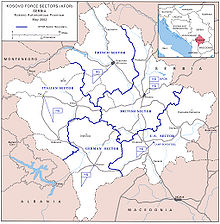
NATO’s initial mandate was:[5]
- to deter renewed hostility and threats against Kosovo by Yugoslav and Serb forces;
- to establish and maintain a secure environment in Kosovo, including public safety and civil order;
- to demilitarise the Kosovo Liberation Army;
- to support the international humanitarian effort;
- to coordinate with and support the international civil presence.
Today, KFOR focuses on building a secure environment in which all citizens, irrespective of their ethnic origins, can live in peace and, with international aid, democracy and civil society are gradually gaining strength. KFOR tasks have included:
- assistance with the return or relocation of displaced persons and refugees;
- reconstruction and demining;
- medical assistance;
- security and public order;
- security of ethnic minorities;
- protection of patrimonial sites;
- border security;
- interdiction of cross-border weapons smuggling;
- implementation of a Kosovo-wide weapons, ammunition and explosives amnesty programme;
- weapons destruction;
- support for the establishment of civilian institutions, law and order, the judicial and penal system, the electoral process and other aspects of the political, economic and social life of the province.
The Contact Group countries have said publicly that KFOR will remain in Kosovo to provide the security necessary to support the provisions of a final settlement of Kosovo's status.[6]
Structure
As of 1 February 2010, the Multinational Task Forces changed the structure and become Multinational Battle Groups.
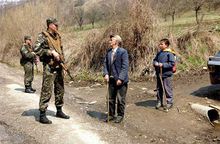
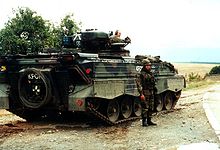

KFOR contingents were originally grouped into 4 regionally based multinational brigades. The brigades were responsible for a specific area of operations, but under a single chain of command under the authority of Commander KFOR. In August 2005, the North Atlantic Council decided to restructure KFOR, replacing the four existing multinational brigades with five task forces, to allow for greater flexibility with, for instance, the removal of restrictions on the cross-boundary movement of units based in different sectors of Kosovo.[6]
- Multinational Battle Group North (MNBG-N):
MNTF-N is deployed in the northern region of Kosovo, headquartered in Novo Selo and is commanded by Colonel Chaxel, French Army).
Contributing nations: Belgium, Denmark, France (Lead nation), Greece, Estonia, Luxemburg, Morocco.
- Multinational Battle Group East (MNBG-E):
MNTF-E is deployed in the eastern region of Kosovo, headquartered near Uroševac and is commanded by Brigadier General Alan S. Dohrmann (U.S. Army) since November 13, 2009. The majority of U.S. Soldiers in MNTF-E come from National Guard units, with a different state taking over each rotation of approximately one year.
Camp Bondsteel serves as the headquarters for Multinational Task Force East (MNTF-E). Camp Monteith had been previously used by the KFOR, but is now the training camp for the Kosovo Security Force (formally the Kosovo Protection Corps).
Contributing nations: Greece, Lithuania, Poland, Romania, Ukraine, United States (Lead nation). The official site is http://www.nato.int/KFOR/
- Multinational Battle Group South (MNBG-S):
MNTF-S is deployed in the southern region of Kosovo, headquartered in Prizren. This Task Force has been established on May 15, 2006 and is commanded by Brigadier General Manfred Hofmeyer (German Army).
Contributing nations: Austria, Germany (Lead Nation), Switzerland, Turkey.
- Multinational Battle Group West (MNBG-W):
MNTF-W is deployed in the region of Metohija, headquartered in Peć and is commanded by Colonel Vincenzo Grasso(Italian Army).
Contributing nations: Italy (lead nation), Slovenia, Hungary, Romania.
- Multinational Battle Group Center (MNBG-C):
MNTF-C is deployed in the region of Drenica, headquartered in Lipljan and is commanded by Brigadier General Seppo Toivonen (Finnish Army).
Contributing nations: Czech Republic, Finland (Lead nation), Ireland, Latvia, Slovakia, Sweden.
- Multinational Specialized Unit (MSU):
MSU is deployed in Pristina and is commanded by Colonel Gianni Massimo Cuneo, (Italian Carabinieri).
The Multinational Specialized Unit (MSU) is a police force with military status, with an overall police capability.
Contributing nations: Italy and France.
- KFOR Tactical Reserve Manoeuvre Battalion (KTM):
KFOR Tactical Reserve Manoeuvre Battalion (KTM) is a Portuguese Battalion level unit, operating as part of KFOR CJSOR since 2005. Its most relevant characteristics are the absence of caveats, capability to deploy by air or ground Kosovo-wide at reduced NTM, CRC trained and self-sustainable for 72 hours, giving COMKFOR a wide variety of possibilities and flexibility of employment.
KTM is under the direct control of COMKFOR and is commanded by Lieutenant Colonel Nuno Maria Vasconcelos Albergaria Pinheiro Moreira (Portuguese Army)
Contributing nations
At its height, KFOR troops numbered 50,000 and came from 39 different NATO / Non-NATO nations. The official KFOR website indicated that in 2008 a total 14,000 soldiers from 34 countries were participating in KFOR.[7]
The nations contributing the most personnel to KFOR at the time included:
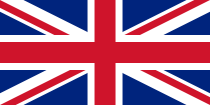 United Kingdom (19,000 troops - now 5)
United Kingdom (19,000 troops - now 5) Germany (8,500 - now 1,507)
Germany (8,500 - now 1,507) United States (7,000 - now 1,480)
United States (7,000 - now 1,480) France (7,000 - now 807)
France (7,000 - now 807) Italy (5,000 - now 1,409)
Italy (5,000 - now 1,409)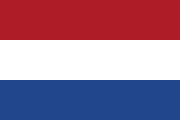 Netherlands (3,600 - now 10)
Netherlands (3,600 - now 10)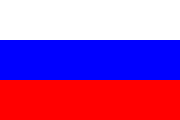 Russia (3,000? - now 0)
Russia (3,000? - now 0) Canada (1,470 - now 5)
Canada (1,470 - now 5).svg.png) Belgium (1,100 - now 99)
Belgium (1,100 - now 99)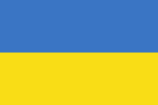 Ukraine (1,300 - now 187)
Ukraine (1,300 - now 187)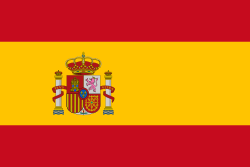 Spain (637 - now 3)
Spain (637 - now 3) Poland (800 - now 227)
Poland (800 - now 227)
Other contributing NATO Nations included:
Other contributing non-NATO Nations have included:
|
|
KFOR Commanders
- Mike Jackson (
 United Kingdom, June 12, 1999 - October 8, 1999),
United Kingdom, June 12, 1999 - October 8, 1999), - Klaus Reinhardt (
 Germany, October 8, 1999 - April 18, 2000),
Germany, October 8, 1999 - April 18, 2000), - Juan Ortuño Such (
 Spain, April 18, 2000 - October 16, 2000),
Spain, April 18, 2000 - October 16, 2000), - Carlo Cabigiosu (
 Italy, October 16, 2000 - April 6, 2001),
Italy, October 16, 2000 - April 6, 2001), - Thorstein Skiaker (
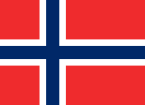 Norway, April 6, 2001 - October 3, 2001),
Norway, April 6, 2001 - October 3, 2001), - Marcel Valentin (
 France, October 3, 2001 - October 4, 2002),
France, October 3, 2001 - October 4, 2002), - Fabio Mini (
 Italy, October 4, 2002 - October 3, 2003),
Italy, October 4, 2002 - October 3, 2003), - Holger Kammerhoff (
 Germany, October 3, 2003 - September 1, 2004),
Germany, October 3, 2003 - September 1, 2004), - Yves de Kermabon (
 France, September 1, 2004 - September 1, 2005),
France, September 1, 2004 - September 1, 2005), - Giuseppe Valotto (
 Italy, September 1, 2005 - September 1, 2006),
Italy, September 1, 2005 - September 1, 2006), - Roland Kather (
 Germany, September 1, 2006 - August 31, 2007),
Germany, September 1, 2006 - August 31, 2007), - Xavier Bout de Marnhac (
 France, August 31, 2007 - August 29, 2008),
France, August 31, 2007 - August 29, 2008), - Giuseppe Emilio Gay (
 Italy, August 29, 2008 - September 8, 2009),
Italy, August 29, 2008 - September 8, 2009), - Markus Bentler (
 Germany, September 8, 2009–present).
Germany, September 8, 2009–present).
Magazines
- The KFOR Chronicle is published monthly, and is cleared for public dissemination. It is also published on the Internet for an international audience.
- The Guardian East is a monthly publication created by the US led Multi-National Task Force - East.
KFOR fatalities
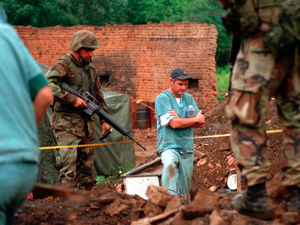
Since the KFOR entered Kosovo in June 1999, 165 NATO soldiers have been killed, mostly in accidents. On October 19, 2004, it was confirmed that 115 NATO soldiers had been killed during the operation.[12] After that 50 more NATO soldiers were confirmed to have died, including 42 Slovak soldiers in a military plane crash in Hungary.
See also
- European Union Force (EUFOR)
- IFOR
- Kosovo Police Service
- Kosovo Protection Corps
- Kosovo status process
- Kosovo Security Force
- NATO
- Peacekeeping
- SFOR
- United Nations Protection Force (UNPROFOR)
References
- ↑ 1.0 1.1 "NATO's role in Kosovo". Nato.int. 10 June 2010. http://www.nato.int/cps/en/natolive/topics_48818.htm. Retrieved 13 June 2010. "Today, just under 10,000 troops from the NATO-led Kosovo Force (KFOR), provided by 31 countries (24 NATO and 7 non-NATO), are still deployed in Kosovo to help maintain a safe and secure environment and freedom of movement for all citizens, irrespective of their ethnic origin."
- ↑ "NATO Topics: NATO in Kosovo". Nato.int. http://www.nato.int/issues/kosovo/index.html. Retrieved 2010-04-28.
- ↑ CNN, No added NATO security in Kosovo, 2008
- ↑ "NATO diskuton për reduktimin e trupave në Kosovë" (in Albanian). Gazeta Express. 9 June 2010. http://www.gazetaexpress.com/web/index.php/artikujt/lexo/32264/C4/C16/. Retrieved 13 June 2010. "Kah fundi i janarit NATO nga rreth 15.000 ka reduktuar trupat në rreth 10.000 ushtarë në përbërje të KFOR-it."
- ↑ "NATO Topics: Kosovo Force (KFOR)". Nato.int. http://www.nato.int/issues/kfor/index.html. Retrieved 2010-04-28.
- ↑ 6.0 6.1 "NATO Topics: Kosovo Force (KFOR) - How did it evolve?". Nato.int. http://www.nato.int/issues/kfor/evolution.html. Retrieved 2010-04-28.
- ↑ "KFOR Press Release". Nato.int. http://www.nato.int/issues/kfor/index.html. Retrieved 2010-04-28.
- ↑ "description". Fuerzaaerea.mil.ar. http://www.fuerzaaerea.mil.ar/misiones/kosovo.html. Retrieved 2010-04-28.
- ↑ pictorial
- ↑ "Azerbaijan to withdraw peacekeepers from Kosovo_English_Xinhua". News.xinhuanet.com. 2008-03-05. http://news.xinhuanet.com/english/2008-03/05/content_7718316.htm. Retrieved 2010-04-28.
- ↑ "RIA Novosti - World - Georgia announces withdrawal of peacekeepers from Kosovo". En.rian.ru. 2008-04-14. http://en.rian.ru/world/20080414/105041588.html. Retrieved 2010-04-28.
- ↑ "British soldier killed in a car accident in Kosovo". Spacewar.com. http://www.spacewar.com/2004/041019134332.plak2o1d.html. Retrieved 2010-04-28.
External links
- KFOR Placemat
- KFOR official site (NATO)
- K-For: The task ahead (from BBC News, June 13, 1999)
- First deaths in K-For operation (from BBC News, June 14, 1999)
- Memorial honors soldiers' sacrifices June 2002: 68 soldiers have died since KFOR entered Kosovo.
- Nato force 'feeds Kosovo sex trade' (from The Guardian, May 7, 2004)
- Radio KFOR